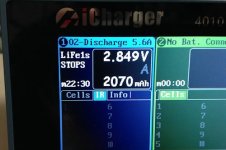Thanks for the much more sensible post. I'm willing to respond to that one.

I said
3.5V would be ideal for the specific situation that I explained above,
not 3.4V.
3.4
5 - 3.5 is what I said that I've read can be float at almost indefinitely... I just started to explain why again, but I was just repeating myself so I stopped. I apologize if I wasn't clear enough, but I don't know how to better explain it.
Now... anyone who "knows" LiFePO4 chemistry (

), in particular A123, knows that there is very little capacity to be had above 3.45V (let alone 3.5V, which is splitting hairs), and also that charging and/or discharging to less than 100% SOC will increase its life (which isn't something I'm even worried about... it's just a side benefit).
There are many examples of capacity tests on A123's, and here's one more that I just did real quick.
This cell is a sacrificial test cell that I've purposely beat on pretty hard. I experimented with soldering the terminals, and purposely not being quick about it because it's a test cell, I seriously overheated it a few times trying out different soldered connection methods. Then it sat for almost two years with a ~full charge, then I soldered on it again. I then proceeded to do many different cycles at many different charge and discharge currents and voltages. The highest continuous discharge current has been 40A, lowest discharge voltage reaching 0.7V before the charger pulled back all of its current (too-slow reaction when at 40A, I actually had it set to a LVC of 2.0V). Highest charge current 15A, highest voltage 3.9V. Multiple 40A discharges gave an average of 141*F case temperature. I've done more than that to it, but that's the gist of it.
This cell won't reach more than ~2180mAh max anymore. I have several other test cells that I've been much easier on but haven't cycled more than a couple times each since they sat for two years, but they've each reached around 2250mAh. So, this one is an absolutely worst case scenario.
I discharged it to a 2.8V resting voltage (2.0V is recommended cut-off, but there's very little left below 2.8V), then charged it at 3A (which is recommended standard charge current), and charged it to only 3.45V. After that I discharged it at 2C (5.3A, which is roughly what I expect to use per cell continuously in operation) back down to 2.8V.
Pictured first is the capacity charging from 2.8V to 3.45V, then the capacity discharging from 3.45V back to 2.8V. Annoyingly, I accidentally hit the stop button early on the discharge when I put my hands down there to take the picture in just a few more moments from then (hence the "STOPS" in the display). I took the pic, then restarted the discharge (the counter starts over) to finish it off at 2.8V, and got 23mAh more, so
2070mAh + 23mAh = 2093 mAh, which is almost exactly equal to the 2089mAh charge, as it should be.


So if we compare that to the full 2300mAh, we get 91% of rated capacity without fully charging
or discharging. However, if we take the maximum capacity that this particular cell has now (about 2180mAh from 2.0V to 3.6V), then we get
96% of actual capacity. And that's charging to "only" 3.45V (not even the 3.5V that I said would be 'ideal' in this situation).
I'm certainly far from the most knowledgeable person on this website and I don't claim to be an expert by any means and I could be wrong about anything I say, but I definitely know more than "nothing about the lifepo4 cell".
I really like fechter's signature. It rings very true.

I was only asking a couple of honest simple questions, not trying to start anything. I'll go back to my hole for now. Too many words, not enough building.




